warning GENESIS GV80 2021 User Guide
[x] Cancel search | Manufacturer: GENESIS, Model Year: 2021, Model line: GV80, Model: GENESIS GV80 2021Pages: 632, PDF Size: 9.37 MB
Page 38 of 632
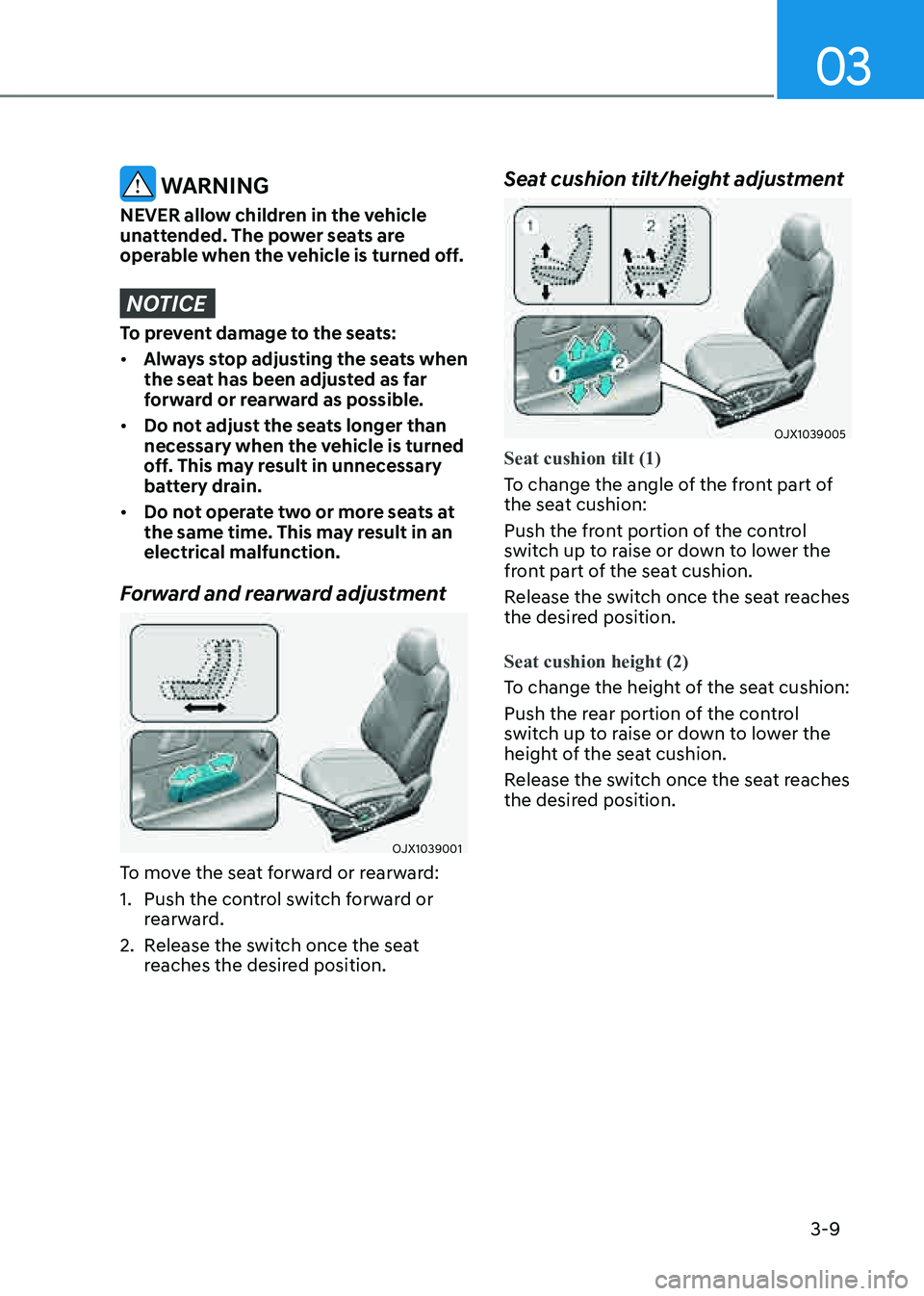
03
3-9
WARNING
NEVER allow children in the vehicle
unattended. The power seats are
operable when the vehicle is turned off.
NOTICE
To prevent damage to the seats:
• Always stop adjusting the seats when
the seat has been adjusted as far
forward or rearward as possible.
• Do not adjust the seats longer than
necessary when the vehicle is turned
off. This may result in unnecessary
battery drain.
• Do not operate two or more seats at
the same time. This may result in an
electrical malfunction.
Forward and rearward adjustment
OJX1039001OJX1039001
To move the seat forward or rearward:
1. Push the control switch forward or
rearward.
2. Release the switch once the seat
reaches the desired position.
Seat cushion tilt/height adjustment
OJX1039005OJX1039005
Seat cushion tilt (1)
To change the angle of the front part of
the seat cushion:
Push the front portion of the control
switch up to raise or down to lower the
front part of the seat cushion.
Release the switch once the seat reaches
the desired position.
Seat cushion height (2)
To change the height of the seat cushion:
Push the rear portion of the control
switch up to raise or down to lower the
height of the seat cushion.
Release the switch once the seat reaches
the desired position.
Page 39 of 632
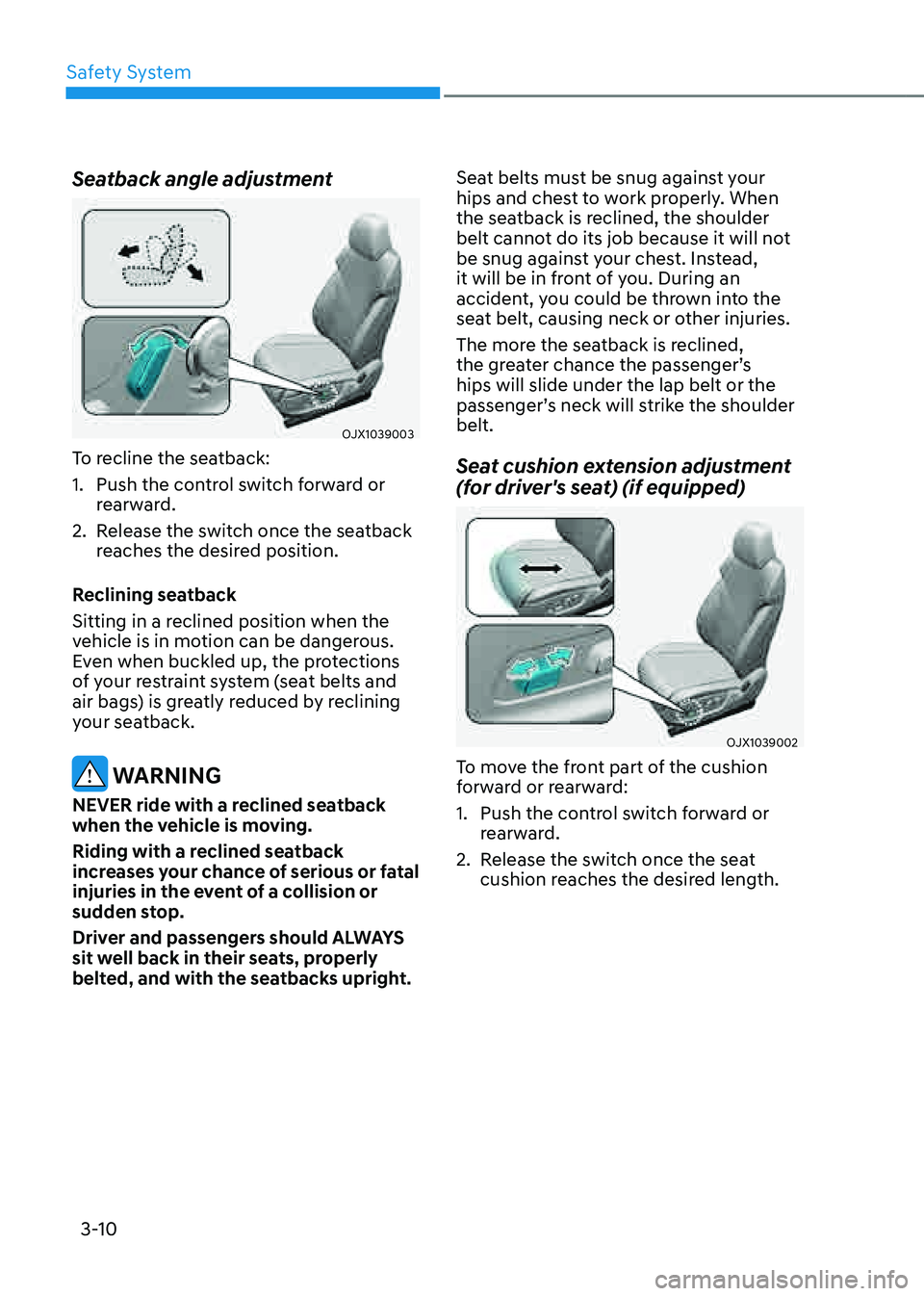
Safety System
3-10
Seatback angle adjustment
OJX1039003OJX1039003
To recline the seatback:
1. Push the control switch forward or
rearward.
2. Release the switch once the seatback
reaches the desired position.
Reclining seatback
Sitting in a reclined position when the
vehicle is in motion can be dangerous.
Even when buckled up, the protections
of your restraint system (seat belts and
air bags) is greatly reduced by reclining
your seatback.
WARNING
NEVER ride with a reclined seatback
when the vehicle is moving.
Riding with a reclined seatback
increases your chance of serious or fatal
injuries in the event of a collision or
sudden stop.
Driver and passengers should ALWAYS
sit well back in their seats, properly
belted, and with the seatbacks upright. Seat belts must be snug against your
hips and chest to work properly. When
the seatback is reclined, the shoulder
belt cannot do its job because it will not
be snug against your chest. Instead,
it will be in front of you. During an
accident, you could be thrown into the
seat belt, causing neck or other injuries.
The more the seatback is reclined,
the greater chance the passenger’s
hips will slide under the lap belt or the
passenger’s neck will strike the shoulder
belt.
Seat cushion extension adjustment
(for driver's seat) (if equipped)
OJX1039002OJX1039002
To move the front part of the cushion
forward or rearward:
1. Push the control switch forward or
rearward.
2. Release the switch once the seat
cushion reaches the desired length.
Page 40 of 632
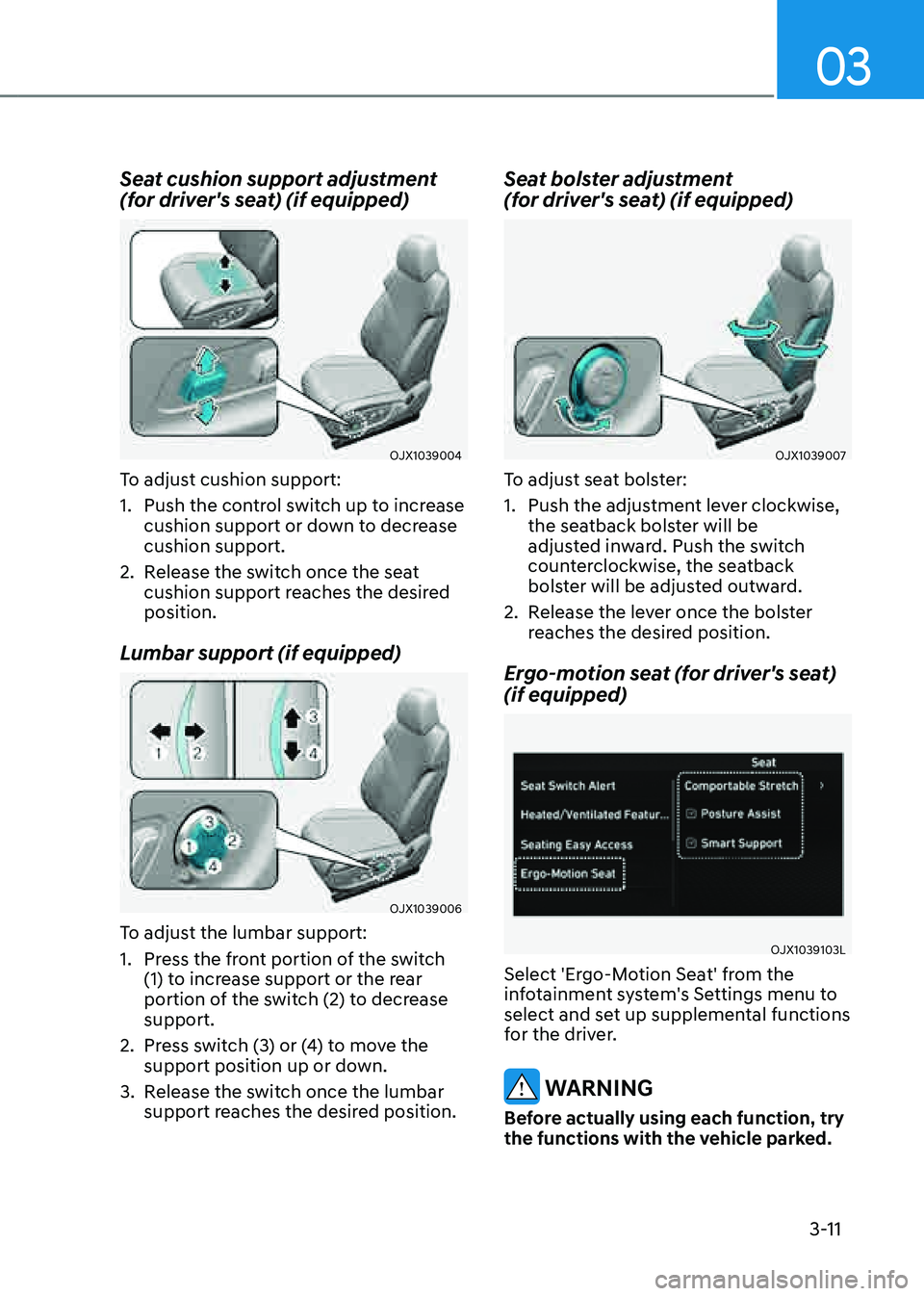
03
3-11
Seat cushion support adjustment
(for driver's seat) (if equipped)
OJX1039004OJX1039004
To adjust cushion support:
1. Push the control switch up to increase
cushion support or down to decrease
cushion support.
2. Release the switch once the seat
cushion support reaches the desired
position.
Lumbar support (if equipped)
OJX1039006OJX1039006
To adjust the lumbar support:
1. Press the front portion of the switch
(1) to increase support or the rear
portion of the switch (2) to decrease
support.
2. Press switch (3) or (4) to move the
support position up or down.
3. Release the switch once the lumbar
support reaches the desired position.
Seat bolster adjustment
(for driver's seat) (if equipped)
OJX1039007OJX1039007
To adjust seat bolster:
1. Push the adjustment lever clockwise,
the seatback bolster will be
adjusted inward. Push the switch
counterclockwise, the seatback
bolster will be adjusted outward.
2. Release the lever once the bolster
reaches the desired position.
Ergo-motion seat (for driver's seat)
(if equipped)
OJX1039103LOJX1039103L
Select 'Ergo-Motion Seat' from the
infotainment system's Settings menu to
select and set up supplemental functions
for the driver.
WARNING
Before actually using each function, try
the functions with the vehicle parked.
Page 42 of 632
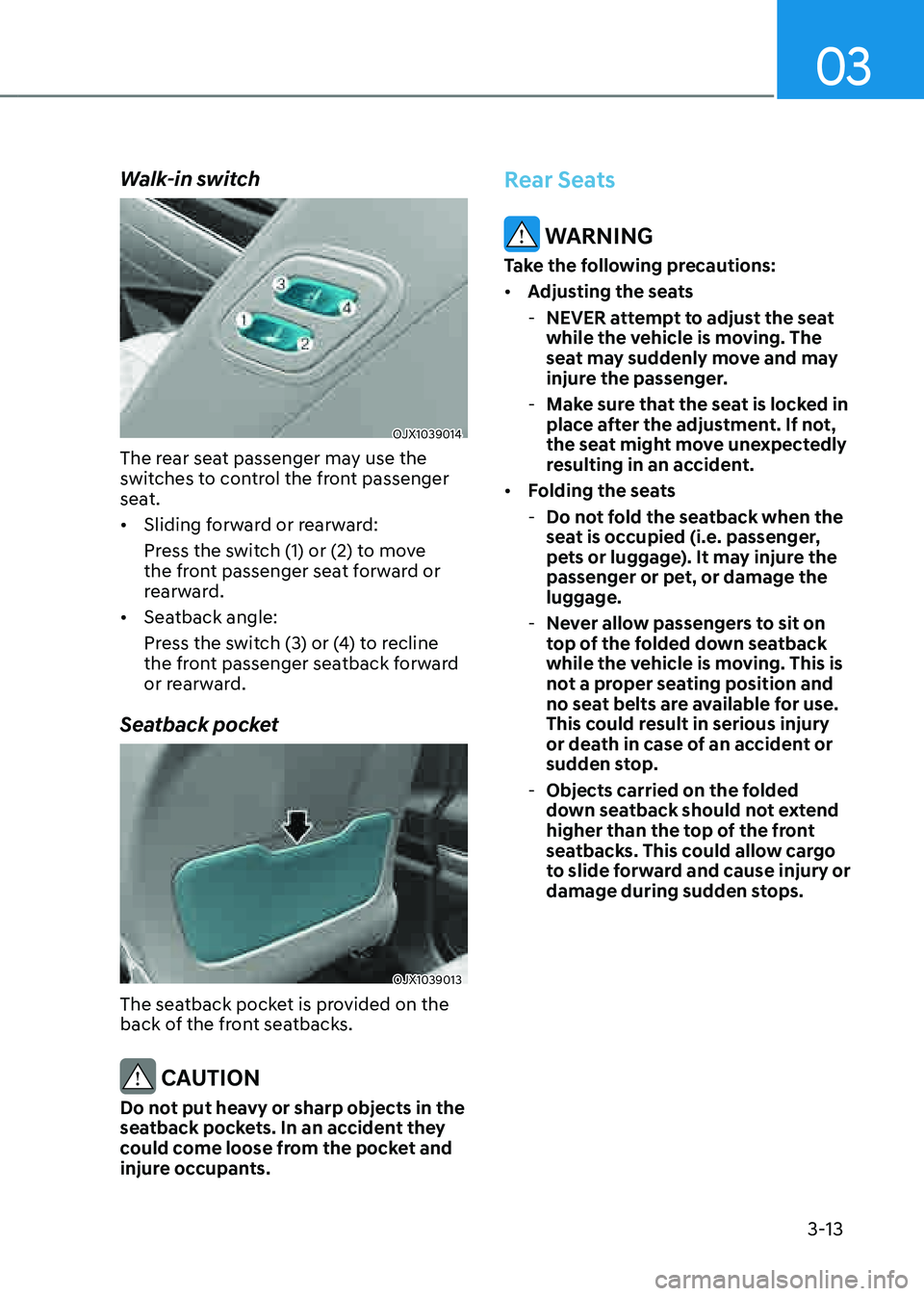
03
3-13
Walk-in switch
OJX1039014OJX1039014
The rear seat passenger may use the
switches to control the front passenger
seat.
• Sliding forward or rearward:
Press the switch (1) or (2) to move
the front passenger seat forward or
rearward.
• Seatback angle:
Press the switch (3) or (4) to recline
the front passenger seatback forward
or rearward.
Seatback pocket
OJX1039013OJX1039013
The seatback pocket is provided on the
back of the front seatbacks.
CAUTION
Do not put heavy or sharp objects in the
seatback pockets. In an accident they
could come loose from the pocket and
injure occupants.
Rear Seats
WARNING
Take the following precautions:
• Adjusting the seats
-NEVER attempt to adjust the seat
while the vehicle is moving. The
seat may suddenly move and may
injure the passenger.
-Make sure that the seat is locked in
place after the adjustment. If not,
the seat might move unexpectedly
resulting in an accident.
• Folding the seats
-Do not fold the seatback when the
seat is occupied (i.e. passenger,
pets or luggage). It may injure the
passenger or pet, or damage the
luggage.
-Never allow passengers to sit on
top of the folded down seatback
while the vehicle is moving. This is
not a proper seating position and
no seat belts are available for use.
This could result in serious injury
or death in case of an accident or
sudden stop.
-Objects carried on the folded
down seatback should not extend
higher than the top of the front
seatbacks. This could allow cargo
to slide forward and cause injury or
damage during sudden stops.
Page 43 of 632
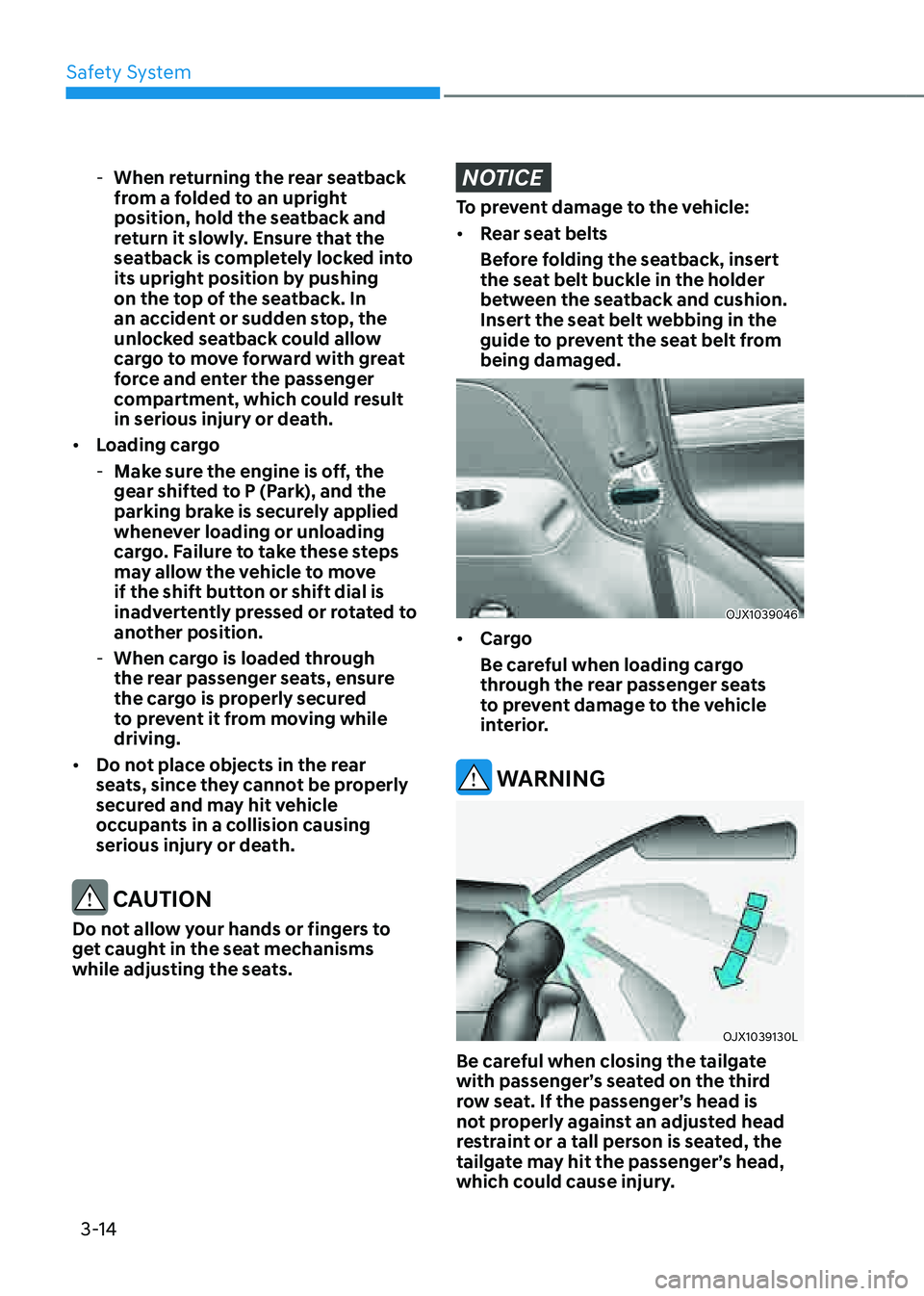
Safety System
3-14
-When returning the rear seatback
from a folded to an upright
position, hold the seatback and
return it slowly. Ensure that the
seatback is completely locked into
its upright position by pushing
on the top of the seatback. In
an accident or sudden stop, the
unlocked seatback could allow
cargo to move forward with great
force and enter the passenger
compartment, which could result
in serious injury or death.
• Loading cargo
-Make sure the engine is off, the
gear shifted to P (Park), and the
parking brake is securely applied
whenever loading or unloading
cargo. Failure to take these steps
may allow the vehicle to move
if the shift button or shift dial is
inadvertently pressed or rotated to
another position.
-When cargo is loaded through
the rear passenger seats, ensure
the cargo is properly secured
to prevent it from moving while
driving.
• Do not place objects in the rear
seats, since they cannot be properly
secured and may hit vehicle
occupants in a collision causing
serious injury or death.
CAUTION
Do not allow your hands or fingers to
get caught in the seat mechanisms
while adjusting the seats.
NOTICE
To prevent damage to the vehicle:
• Rear seat belts
Before folding the seatback, insert
the seat belt buckle in the holder
between the seatback and cushion.
Insert the seat belt webbing in the
guide to prevent the seat belt from
being damaged.
OJX1039046OJX1039046
• Cargo
Be careful when loading cargo
through the rear passenger seats
to prevent damage to the vehicle
interior.
WARNING
OJX1039130LOJX1039130L
Be careful when closing the tailgate
with passenger’s seated on the third
row seat. If the passenger’s head is
not properly against an adjusted head
restraint or a tall person is seated, the
tailgate may hit the passenger’s head,
which could cause injury.
Page 48 of 632
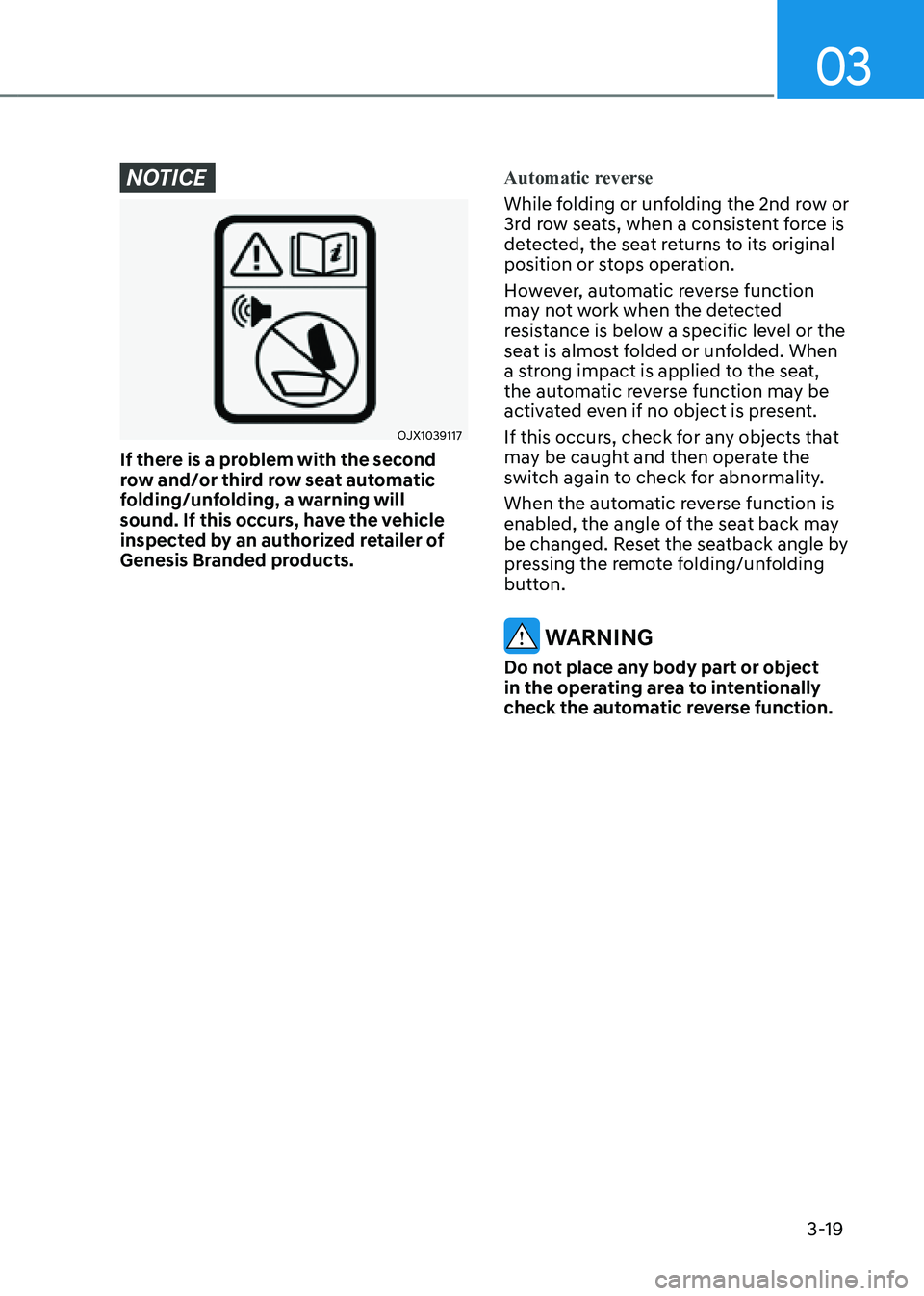
03
3-19
NOTICE
OJX1039117OJX1039117
If there is a problem with the second
row and/or third row seat automatic
folding/unfolding, a warning will
sound. If this occurs, have the vehicle
inspected by an authorized retailer of
Genesis Branded products.Automatic reverse
While folding or unfolding the 2nd row or
3rd row seats, when a consistent force is
detected, the seat returns to its original
position or stops operation.
However, automatic reverse function
may not work when the detected
resistance is below a specific level or the
seat is almost folded or unfolded. When
a strong impact is applied to the seat,
the automatic reverse function may be
activated even if no object is present.
If this occurs, check for any objects that
may be caught and then operate the
switch again to check for abnormality.
When the automatic reverse function is
enabled, the angle of the seat back may
be changed. Reset the seatback angle by
pressing the remote folding/unfolding
button.
WARNING
Do not place any body part or object
in the operating area to intentionally
check the automatic reverse function.
Page 51 of 632

Safety System
3-22
Head Restraint
The vehicle’s front and rear (second row
and/or third row) seats have adjustable
head restraints. The head restraints
provide comfort for passengers, but
more importantly they are designed to
help protect passengers from whiplash
and other neck and spinal injuries during
an accident, especially in a rear impact
collision.
WARNING
To reduce the risk of serious injury or
death in an accident, take the following
precautions when adjusting your head
restraints:
• Always properly adjust the head
restraints for all passengers BEFORE
starting the vehicle.
• NEVER let anyone ride in a seat
with the head restraint removed or
reversed.
•
OHI039190NOHI039190N
Adjust the head restraints so the
middle of the head restraint is at the
same height as the height of the top
of the eyes.
• NEVER adjust the head restraint
position of the driver’s seat when the
vehicle is in motion.
• Adjust the head restraint as close to
the passenger’s head as possible. Do
not use a seat cushion that holds the
body away from the seatback.
• Make sure the head restraint locks
into position after adjusting it.
WARNING
OJX1039115OJX1039115
When sitting on the rear seat, do not
adjust the height of the head restraint
to the lowest position.
CAUTION
When there is no occupant in the rear
seats, adjust the height of the head
restraint to the lowest position. The
rear seat head restraint can reduce the
visibility of the rear area.
NOTICE
To prevent damage, NEVER hit or pull
on the head restraints.
Page 53 of 632

Safety System
3-24
OJX1039011OJX1039011
Removal/Reinstall
To remove the head restraint:
1. Recline the seatback (2) with the
seatback angle switch (1).
2. Raise the head restraint as far as it can
go.
3. Press the head restraint release button
(3) while pulling the head restraint up
(4).
WARNING
NEVER allow anyone to travel in a seat
with the head restraint removed.
OJX1039012OJX1039012
To reinstall the head restraint:
1. Recline the seatback.
2. Put the head restraint poles (2) into
the holes while pressing the release
button (1).
3. Adjust the head restraint to the
appropriate height.
4. Recline the seatback (4) with the
seatback angle switch (3).
WARNING
Always make sure the head restraint
locks into position after reinstalling and
adjusting it properly.
Page 56 of 632
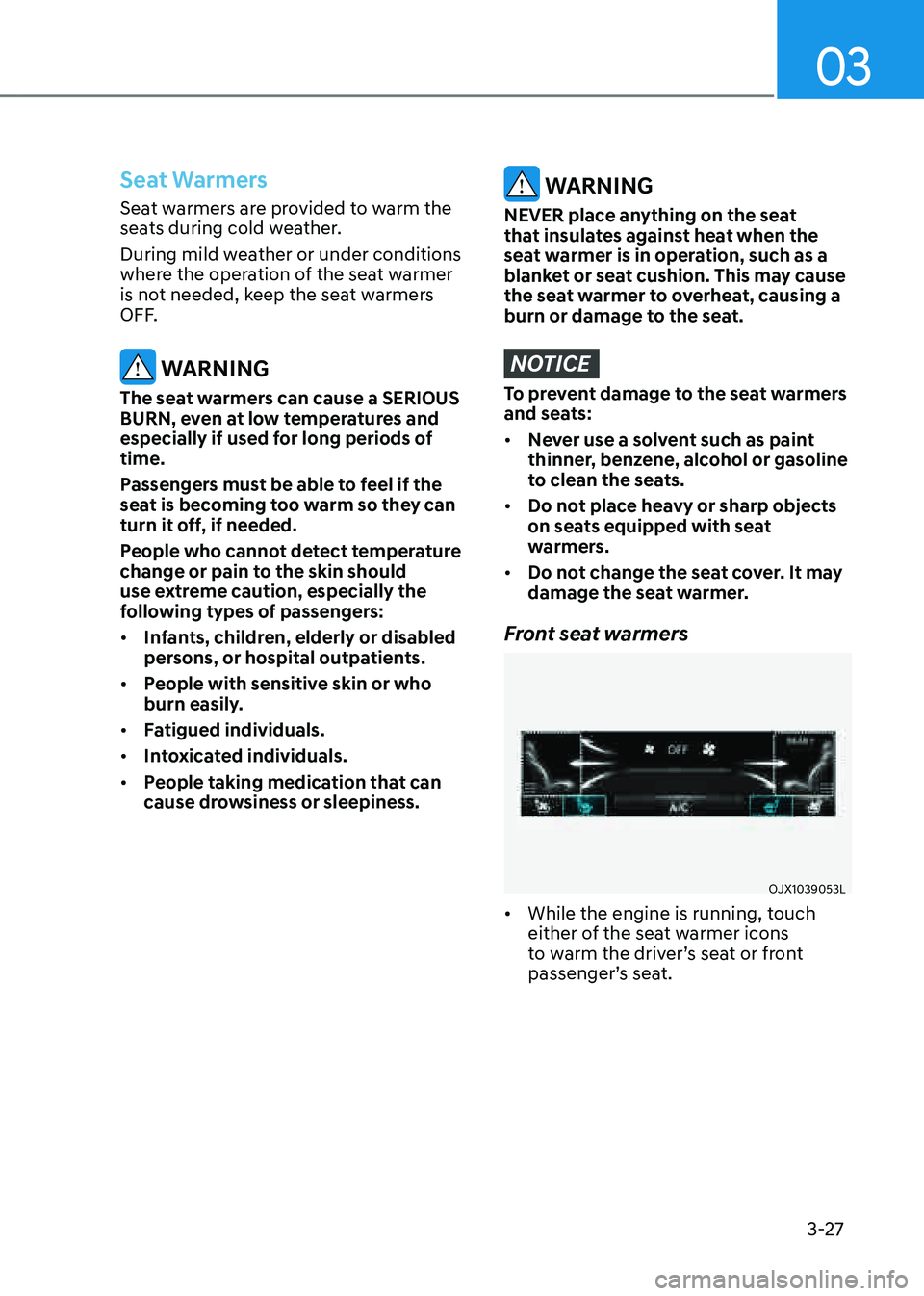
03
3-27
Seat Warmers
Seat warmers are provided to warm the
seats during cold weather.
During mild weather or under conditions
where the operation of the seat warmer
is not needed, keep the seat warmers
OFF.
WARNING
The seat warmers can cause a SERIOUS
BURN, even at low temperatures and
especially if used for long periods of
time.
Passengers must be able to feel if the
seat is becoming too warm so they can
turn it off, if needed.
People who cannot detect temperature
change or pain to the skin should
use extreme caution, especially the
following types of passengers:
• Infants, children, elderly or disabled
persons, or hospital outpatients.
• People with sensitive skin or who
burn easily.
• Fatigued individuals.
• Intoxicated individuals.
• People taking medication that can
cause drowsiness or sleepiness.
WARNING
NEVER place anything on the seat
that insulates against heat when the
seat warmer is in operation, such as a
blanket or seat cushion. This may cause
the seat warmer to overheat, causing a
burn or damage to the seat.
NOTICE
To prevent damage to the seat warmers
and seats:
• Never use a solvent such as paint
thinner, benzene, alcohol or gasoline
to clean the seats.
• Do not place heavy or sharp objects
on seats equipped with seat
warmers.
• Do not change the seat cover. It may
damage the seat warmer.
Front seat warmers
OJX1039053LOJX1039053L
• While the engine is running, touch
either of the seat warmer icons
to warm the driver’s seat or front
passenger’s seat.
Page 62 of 632
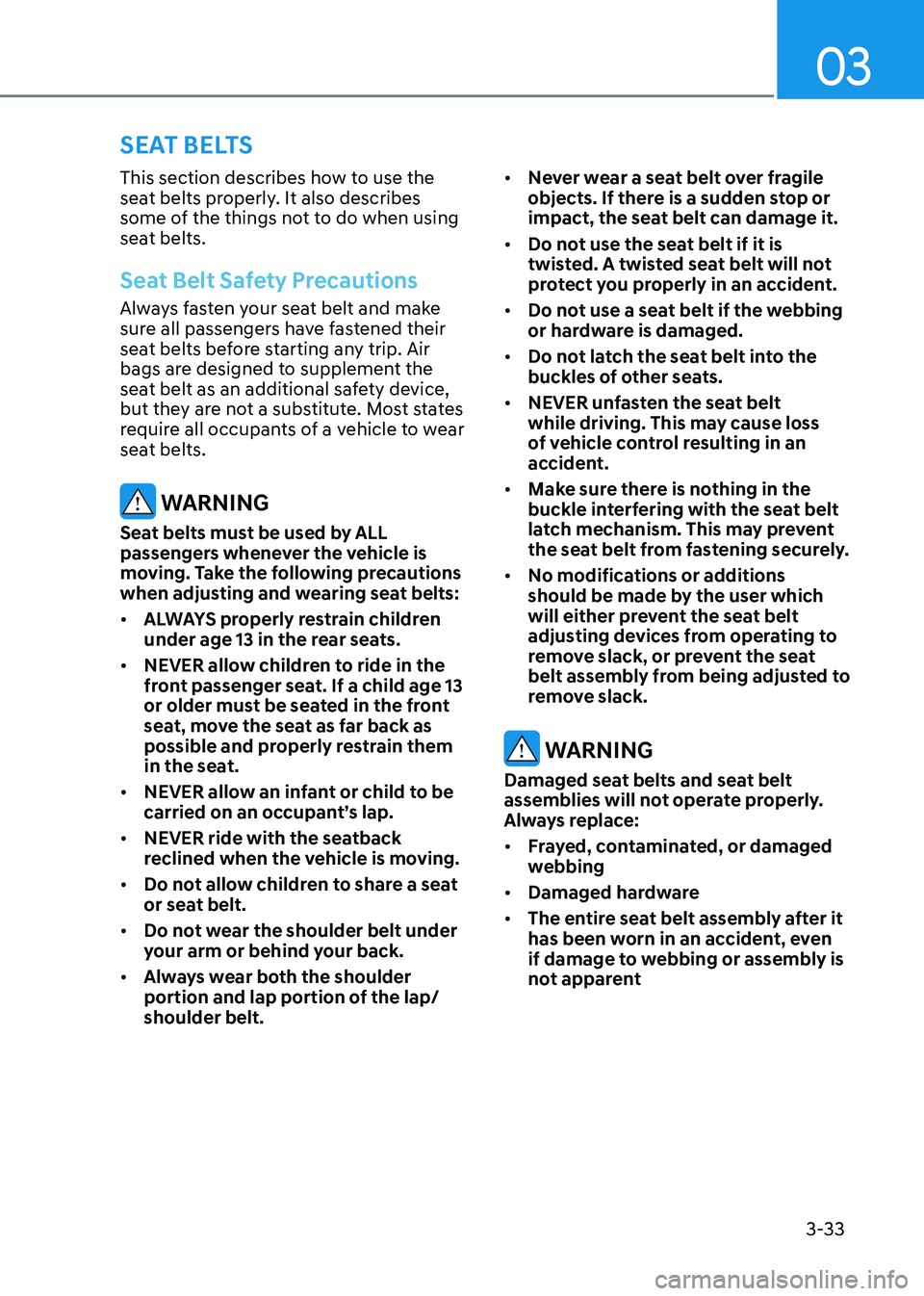
03
3-33
This section describes how to use the
seat belts properly. It also describes
some of the things not to do when using
seat belts.
Seat Belt Safety Precautions
Always fasten your seat belt and make
sure all passengers have fastened their
seat belts before starting any trip. Air
bags are designed to supplement the
seat belt as an additional safety device,
but they are not a substitute. Most states
require all occupants of a vehicle to wear
seat belts.
WARNING
Seat belts must be used by ALL
passengers whenever the vehicle is
moving. Take the following precautions
when adjusting and wearing seat belts:
• ALWAYS properly restrain children
under age 13 in the rear seats.
• NEVER allow children to ride in the
front passenger seat. If a child age 13
or older must be seated in the front
seat, move the seat as far back as
possible and properly restrain them
in the seat.
• NEVER allow an infant or child to be
carried on an occupant’s lap.
• NEVER ride with the seatback
reclined when the vehicle is moving.
• Do not allow children to share a seat
or seat belt.
• Do not wear the shoulder belt under
your arm or behind your back.
• Always wear both the shoulder
portion and lap portion of the lap/
shoulder belt.
• Never wear a seat belt over fragile
objects. If there is a sudden stop or
impact, the seat belt can damage it.
• Do not use the seat belt if it is
twisted. A twisted seat belt will not
protect you properly in an accident.
• Do not use a seat belt if the webbing
or hardware is damaged.
• Do not latch the seat belt into the
buckles of other seats.
• NEVER unfasten the seat belt
while driving. This may cause loss
of vehicle control resulting in an
accident.
• Make sure there is nothing in the
buckle interfering with the seat belt
latch mechanism. This may prevent
the seat belt from fastening securely.
• No modifications or additions
should be made by the user which
will either prevent the seat belt
adjusting devices from operating to
remove slack, or prevent the seat
belt assembly from being adjusted to
remove slack.
WARNING
Damaged seat belts and seat belt
assemblies will not operate properly.
Always replace:
• Frayed, contaminated, or damaged
webbing
• Damaged hardware
• The entire seat belt assembly after it
has been worn in an accident, even
if damage to webbing or assembly is
not apparent
SEAT BELTS